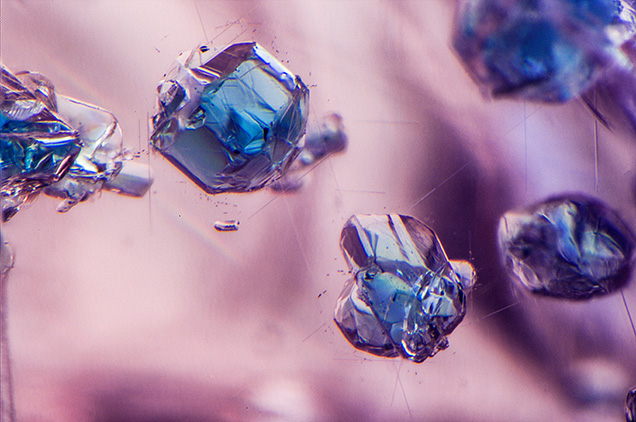Garnet with Apatite Inclusions


The authors recently examined a 3.07 ct garnet sample acquired from Ravenstein Gem Co. by author NR. This gem material, marketed online as “dragon” garnet as an allusion to the mythical creature’s changing eye color, was reportedly from a new find at an undisclosed locality in Africa. It is also notable that Lotus Gemology has reported similar material from Tanzania (Summer 2022 G&G Micro-World, pp. 226–227). The garnet was a delicate purplish pink color under daylight-equivalent lighting (figure 1, left) and showed a fairly strong red fluorescence when exposed to long-wave ultraviolet light (figure 1, right). Also of note, this sample, as well as many of the other examples showcased online, contained vibrant blue inclusions of apatite (figure 2) as well as typical needle-like silk and minute fluid inclusions.


Gemological testing revealed a refractive index measurement of 1.741 and a hydrostatic specific gravity of 3.81. Further gemological testing with laser ablation–inductively coupled plasma–mass spectrometry revealed the major composition to be pyrope (61.5 mol.%), spessartine (29.0 mol.%), grossular (6.5 mol.%), and almandine (2.6 mol.%), a chemistry consistent with pyralspite-series garnets. Notable trace elements in significant quantities were chromium (660 ppmw) and vanadium (343 ppmw) in addition to the rare earth elements yttrium (1206 ppmw), erbium (222 ppmw), and ytterbium (420 ppmw). The ultraviolet/visible/near-infrared (UV-Vis-NIR) spectrum revealed absorption bands that were consistent with the chemical analysis (figure 3), indicating that the color of the garnet results from a mixture of manganese, iron, chromium, and vanadium. Raman analysis confirmed the blue inclusions as apatite. It is also notable that the garnet sample showed a weak color change in daylight compared to various non-standardized, commercially available LED types of lighting, changing from purplish pink to pink-orange. Photoluminescence testing with a 514 nm laser revealed a strong chromium-related emission, consistent with the red fluorescence observed with long-wave UV exposure (figure 4).
The strong red fluorescence, color change under certain LED lights, and presence of significant rare earth elements and vibrant blue apatite inclusions make it quite interesting for any gem collector.
.jpg)


